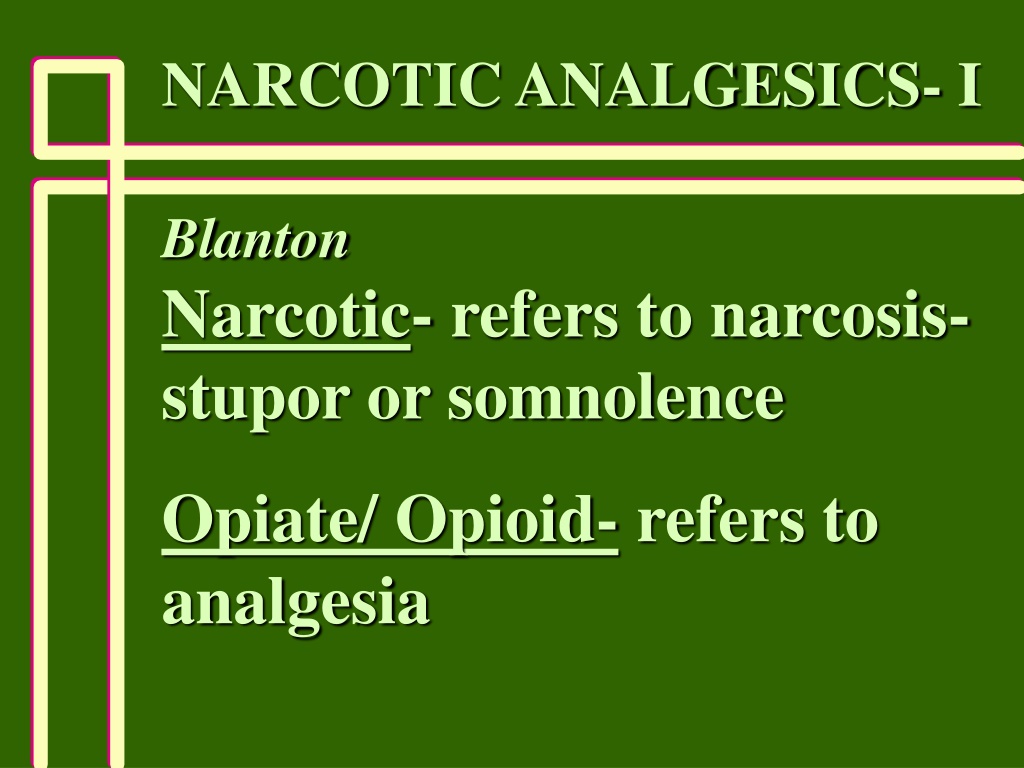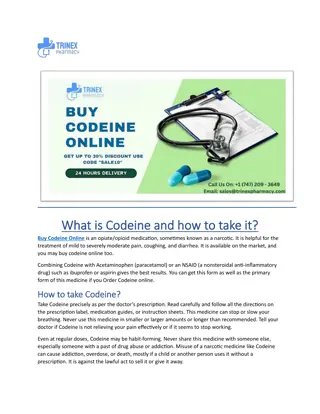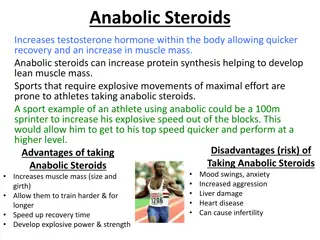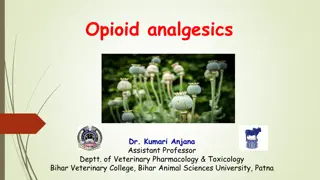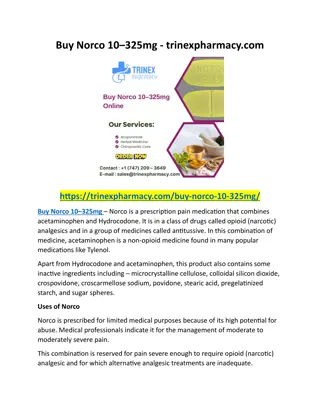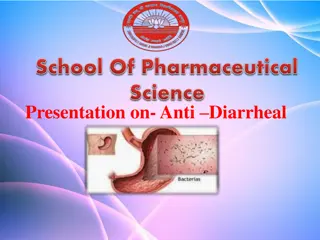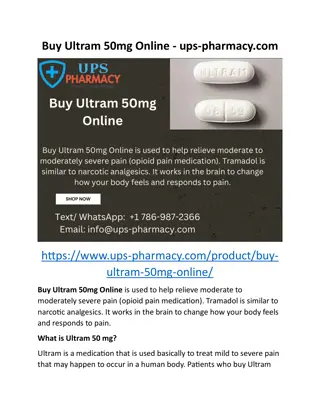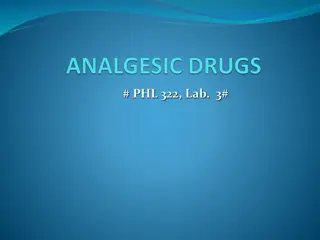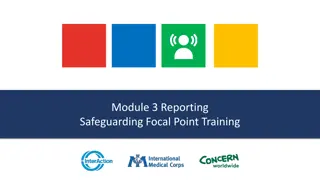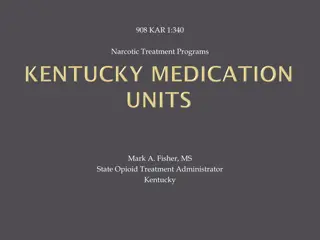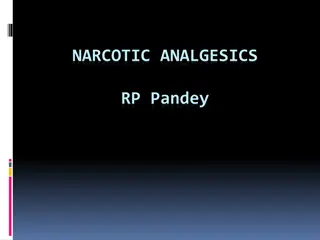Understanding Narcotic Analgesics and Opiates: History, Mechanisms, and Uses
Delve into the world of narcotic analgesics and opiates, exploring the history of opium poppy, morphine derivatives, opioid compounds, and the pharmacology mechanisms of action. Discover the uses of opiates in analgesia, preanesthetic medication, and more, alongside the endogenous ligands involved. Gain insights into the mechanisms of opiates and their impact on neurotransmitter release and neuronal hyperpolarization.
Download Presentation

Please find below an Image/Link to download the presentation.
The content on the website is provided AS IS for your information and personal use only. It may not be sold, licensed, or shared on other websites without obtaining consent from the author. Download presentation by click this link. If you encounter any issues during the download, it is possible that the publisher has removed the file from their server.
E N D
Presentation Transcript
NARCOTIC ANALGESICS- I Blanton Narcotic- refers to narcosis- stupor or somnolence Opiate/ Opioid- refers to analgesia
Graphic Photos Of Overdosed Adults With Child In Car Put Ohio Heroin Epidemic In Spotlight
HISTORY Opium Poppy Papaver somniferum -Opium = crude extract -Morphine = purified constituent from Morpheus-Greek god of dreams
Uses of Opiates -Analgesia -Preanesthetic Medication (sedative) -Pulmonary Edema -Anesthesia -Spinal Analgesia -Cough -Diarrhea -Recreation
Opioid Compounds -Extracts of Opium- morphine, codeine, papaverine, etc -Synthetic Opioids- Agonists, Antagonists, Mixed Agonist/ Antagonists -Opiopeptins- -endorphin, Enkephalins, Dynorphin
Morphine Derivatives Agonists- substitutions: at 3, 6, 17 positions. Antagonists- substitutions: At 17 position (or at 14)
Opiates- Phamarmacology Mechanism(s) of Action -*mu receptor -kappa receptor -delta receptor -N/OFQ- nociceptin, -Orphanin FQ
Opiates- Mechanisms -G-protein coupling -Inhibition of cAMP formation (1) Activation of K+ channels (postsynaptic) -Hyperpolarization of Neuron
Opiates- Mechanism (2) Inhibition of VG Ca++ channels (presynaptic) -Depression of Neurotransmitter Release: -NE, DA -5-HT -ACh -Substance P
Endogenous Ligands Morphine and Related Ligands Peptides: -Proopiomelanocortin-POMC: endorphins -Proenkephalin A:enkephalins -Proenkephalin B:dynorphins
Endogenous Ligands CNS and Nonnervous Tissues POMC: CNS- pain areas Pituitary, and Pancreas Proenkephalin A, B: CNS- Widespread: pain, behavior, motor, autonomic
Endogenous Peptides Differential Processing of Precursors = Different Peptide Products in Tissues
Opiates- CNS Effects Analgesia (mu receptors) -change perception of pain -change reaction to pain -raise threshold for pain -decrease nociceptive pain greater than neuropathic pain
Opiates- Analgesia -Dull pain -Severe pain -Drowsiness -Impairment- variable -Antagonism of Opiate Side Effects
Mechanisms of Analgesia Ascending Pathways- spinothalamic tract Descending Pathways- bulbospinal pathways Synergy of Two Pathways
Opiates- CNS Effects Ventral Tegmentum Euphoria- Dysphoria- mu and delta receptors kappa receptors
Opiates- CNS Effects Alter Hypothalamic Heat Regulatory Mechanism Neuroendocrine (mu)- Decrease LH, FSH, ACTH, -endorphin Increase Prolactin, ADH
Opiates- CNS Effects Miosis- (mu and kappa)- Stimulation of PNS innervation of pupil Convulsions- (mu, kappa,delta)- High concentrations, inhibition of GABA release
Opiates- CNS Effects Antitussive Effects- Depression of medullary cough centers Nausea and Vomiting- Stimulation of CTZ
Opiates- Respiration Therapeutic Concentrations -Concentration Dependent -Reduction in rate, minute volume, and tidal exchange Few Clinical Problems * Exception: respiratory disease, coadministration of respiratory depressants
Opiates- Respiration Suppression of Brainstem 1) Centers that control rhythm 2) Centers that sense pCO2 Hypoxic Stimulation Intact- O2 ---> apnea
Opiates- Bronchoconstriction Histamine release -CNS depression of respiration -CNS suppression of cough reflex Caution: asthma, cor pulmonale COPD
Opiates- Cardiovascular Therapeutic Concentrations -Supine Position -Little Effects on bp, rate, rhythm -Supine --> Standing Position peripheral vasodilation decreased peripheral resistance inhibition of baroreceptor reflex
Opiates- CSF May Increase CSF Pressure Contraindicated in head injury, intracranial lesions
Opiates- GI Effects Inhibitory actions -Delay gastric emptying -Delay passage through small and large intestines -Increase anal sphincter tone -Decrease defecation reflex -Constipation
Opiates- Miscellaneous -Contraction of the bile duct and sphincter of Oddi -Renal/Bladder Function Depressed -Labor Prolonged
Tolerance High Degree Analgesia Euphoria Dysphoria Mental Clouding Sedation Resp. Depression N & V Cough Supression Moderate Bradycardia Miosis Constipation Convulsions Antagonist None Actions
Study Guide Know: 1) Uses of Opioids 2) Classes of Opioids- Agonists, Antagonists, etc. 3) Receptors associated with opiates- mu vs kappa vs delta- What functions do they serve?
Study Guide 4) Opiate analgesia- characteristics 5) Effects of opiates on GI tract function, respiration,cardio- vascular function, cough
Opiates- Pharmacokinetics Routes: PO, SL, Nasal, Rectal, Dermal IV, IM First Pass Effect- (PO)- High for Morphine (25% of the oral dose is bioavailable)
Opiates- Pharmacokinetics IV Route more lipophilic- more penetrance of BBB Morphine- poor penetrance Fentanyl- redistribution
Opiates- Pharmacokinetics Metabolism of Morphine Glucuronidation of the 3 or 6- OH Morphine 6-Glucuronide is a potent analgesic
Patient Controlled Analgesia -Automated Device- delivery of opiate for postoperative pain, cancer pain, or other conditions -Device programmed for dose and interval between doses
Opiate Use and Dyspnea Pulmonary Edema- Left Ventricular Failure Reduction in fear/anxiety Reduction in peripheral resistance
Strong Agonists Phenanthrene Class Morphine Oxycodone Heroin -More Potent -Better Access to BBB -Does not bind to opiate receptor itself. Is metabolized to morphine (the active agent)
Strong Agonists Phenylheptylamine Class Methadone -similar analgesic action as morphine -better bioavailability than morphine -analgesic and addiction therapy
Strong Agonists Phenylpiperidine Class Meperidine (meh-pehr-ih-deen) -less potent but higher availability than morphine -antimuscarinic actions -less constipating -not antitussive -no effects on labor
Strong Agonists Phenylpiperidine Class Fentanyl/Sufentanil (sue-fen-tuh-nil) -analgesia >> morphine -short duration -useful in anesthesia -postoperative analgesia
Moderate Agonists Phenanthrene Class Codeine -less potent than morphine -10% metabolized to morphine- accounts for analgesia! -oral- with aspirin or acetaminophen -antitussive in its own right
Moderate Agonists Phenylheptylamine Class Propoxyphene (pro-pox-ee-feen; Darvon) -related to methadone -potency between aspirin and codeine -no antitussive effect
Mild Agonists Phenylpiperidine Class Diphenoxylate/Loperamide (die-fen-ox-ih-late/ low-pehr-uh-mide) -not analgesic -low abuse potential -antidiarrheal activity
Agonist/Antagonists- Mixed Developed for analgesia with less liability kappa agonists mu antagonists or weak agonists
Pentazocine (Mixed) (pen-taz-oh-seen) kappa agonist mu agonist/antagonist Comparison with Morphine: -Less potent, addictive liability -Precipitates withdrawal -Similar respiratory depression
Butorphanol (Mixed) (byoo-tore-fan-ahl) -Similar to Pentazocine -kappa agonist -mu antagonist -More potent than morphine -Increases in cardiac workload
Buprenorphine (byoo-pre-nore-feen) -Partial mu agonist -kappa antagonist? -More potent than morphine -Can precipitate withdrawals -Addictive Liability, but good analgesic with reduced potential for abuse!
Uses of Opioid Antagonists 1) narcotic poisoning 2) reduce side effects in opioid anesthesia 3) reverse neonatal respiratory depression 4) opioid addiction treatment 5) alcoholism treatment
Naloxone -Rapid Acting -Short Duration Multiple Doses
Naltrexone -Orally Effective -Treatment for Alcoholism -Liver Dysfunction
Naloxegol (Movantik)PEGylated-Naloxone -Peripherally acting mu receptor antagonist (PEGylated form of naloxone- does not penetrate the blood brain barrier) -oral treatment for opioid-induced constipation in adults with chronic non- cancer pain (FDA approved 2014).
